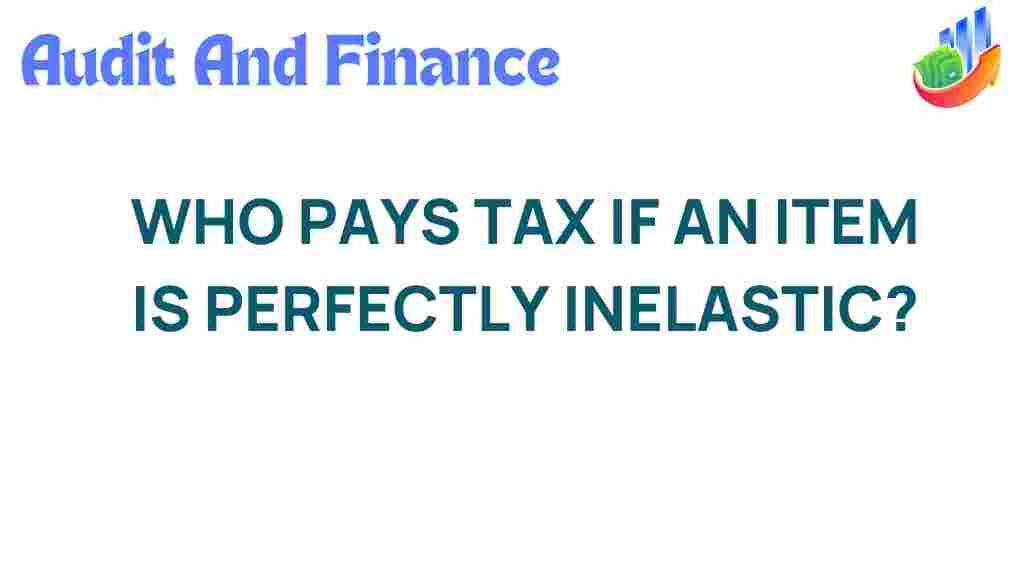The Intriguing Case of Perfectly Inelastic Demand and Taxation
Taxation is a fundamental aspect of economic theory that impacts consumer behavior, market dynamics, and fiscal policy. One of the most intriguing concepts within taxation is perfectly inelastic demand. This phenomenon occurs when the quantity demanded of a good remains constant regardless of changes in price, including taxes. Understanding perfectly inelastic demand is crucial for analyzing tax incidence and its effects on both consumers and producers. In this article, we will delve into the intricacies of perfectly inelastic demand, its implications for taxation, and how it shapes economic policy.
Understanding Perfectly Inelastic Demand
Perfectly inelastic demand refers to a situation where the demand for a product does not change even when the price increases significantly. This concept is typically represented graphically by a vertical demand curve, indicating that consumers will buy the same quantity regardless of price fluctuations.
- Characteristics of Perfectly Inelastic Demand:
- The quantity demanded remains constant.
- Consumer preferences are fixed.
- Goods are often necessities (e.g., life-saving drugs).
Perfectly inelastic demand is an extreme case of inelasticity, which is more common in real-world scenarios. Most goods exhibit some degree of elasticity, but perfectly inelastic goods are rare. An example includes essential medications for chronic diseases, where patients have no choice but to purchase at any price.
Taxation and Perfectly Inelastic Demand
When taxation is applied to goods with perfectly inelastic demand, the tax burden primarily falls on consumers. Since their demand does not change, they will continue purchasing the same amount despite increased prices due to taxes. This scenario leads to unique implications for tax incidence.
Tax Incidence Explained
Tax incidence refers to the distribution of the tax burden between consumers and producers. In the case of perfectly inelastic demand:
- The entire tax burden is borne by consumers.
- Producers do not reduce the quantity supplied, as demand remains unchanged.
- Price increases directly impact consumer spending without affecting the quantity consumed.
This phenomenon illustrates a critical aspect of fiscal policy, as governments can generate revenue without significantly affecting the overall consumption of essential goods.
Consumer Behavior and Market Dynamics
Understanding consumer behavior is essential for analyzing the effects of taxation on perfectly inelastic goods. Consumers tend to prioritize their spending on necessities, which leads to a consistent demand despite rising prices. This behavior can be analyzed through the following lenses:
- Price Sensitivity: Consumers of perfectly inelastic goods are insensitive to price changes, making them willing to pay any price for essential goods.
- Budget Allocation: Households may allocate a significant portion of their budgets to these goods, often at the expense of other discretionary expenditures.
As a result, market dynamics shift, with producers experiencing stable sales even when faced with increased production costs due to taxation.
Fiscal Policy Implications
The implications of perfectly inelastic demand extend beyond immediate market behavior. Policymakers often consider these dynamics when designing fiscal policies. Here are some key considerations:
- Revenue Generation: Governments may target goods with perfectly inelastic demand for taxation, knowing that they can raise substantial revenue without significantly reducing consumption.
- Equity Considerations: Policymakers must consider the equity of taxing essential goods, as this can disproportionately affect lower-income households.
- Behavioral Impact: Understanding that consumers will continue to purchase essential goods despite price increases allows for better forecasting of consumer behavior under different tax scenarios.
Step-by-Step Analysis of Perfectly Inelastic Demand and Taxation
To fully grasp the interaction between perfectly inelastic demand and taxation, let’s break it down into a step-by-step analysis:
Step 1: Identify the Product
Choose a good that is commonly accepted as having perfectly inelastic demand, such as insulin for diabetics or other critical medications.
Step 2: Analyze Demand Characteristics
Assess the characteristics of the good, including the necessity of the product, consumer preferences, and the lack of substitutes.
Step 3: Apply a Tax
Consider the introduction of a tax on the product. Analyze how this tax affects the market price and total spending by consumers.
Step 4: Observe Consumer Behavior
Monitor consumer behavior to see if the quantity demanded changes. In the case of perfectly inelastic demand, it will remain constant despite the price increase.
Step 5: Evaluate Tax Incidence
Determine how much of the tax burden is passed on to consumers versus producers. For perfectly inelastic demand, the entire burden falls on consumers.
Common Challenges and Troubleshooting Tips
While the theory of perfectly inelastic demand is straightforward, real-world applications can present challenges. Here are some common issues and troubleshooting tips:
- Challenge 1: Misidentifying Demand Elasticity
Sometimes, goods are mistakenly classified as perfectly inelastic. Always analyze market data and consumer behavior before concluding.
- Challenge 2: Policy Backlash
Taxing essential goods can lead to public outcry and backlash. Policymakers should consider alternative revenue sources or tax structures that do not burden consumers disproportionately.
- Challenge 3: Market Changes
Consumer preferences and market conditions can change. Continuous monitoring and adjustment of fiscal policies are necessary to ensure they remain effective.
Conclusion
The case of perfectly inelastic demand and taxation presents a fascinating intersection of economic theory, consumer behavior, and fiscal policy. By understanding the implications of this unique demand characteristic, policymakers can make informed decisions about taxation that can effectively generate revenue while considering equity and consumer welfare.
In essence, perfectly inelastic demand highlights the resilience of consumer behavior in the face of price changes and underscores the importance of careful economic analysis in shaping effective fiscal policies. As markets evolve and consumer preferences shift, ongoing research and adaptation will be key to navigating the complexities of taxation and demand.
For further reading on taxation and economic theory, check out this comprehensive guide that delves deeper into various economic concepts.
Additionally, to explore more about market dynamics and fiscal policies, visit this resource for updated insights and analyses.
This article is in the category Taxation and created by AuditAndFinance Team
